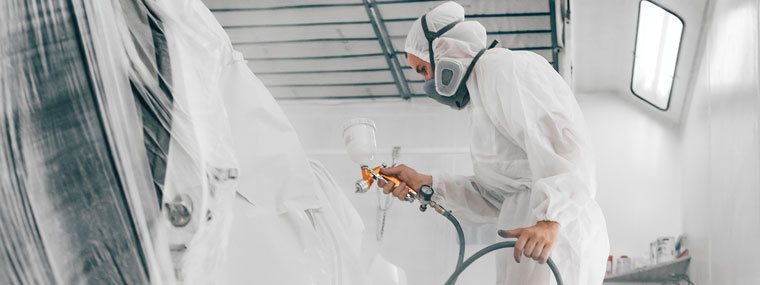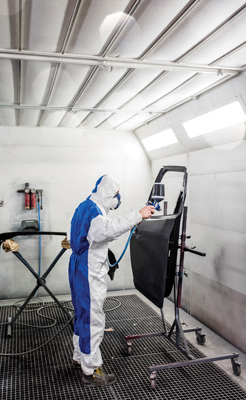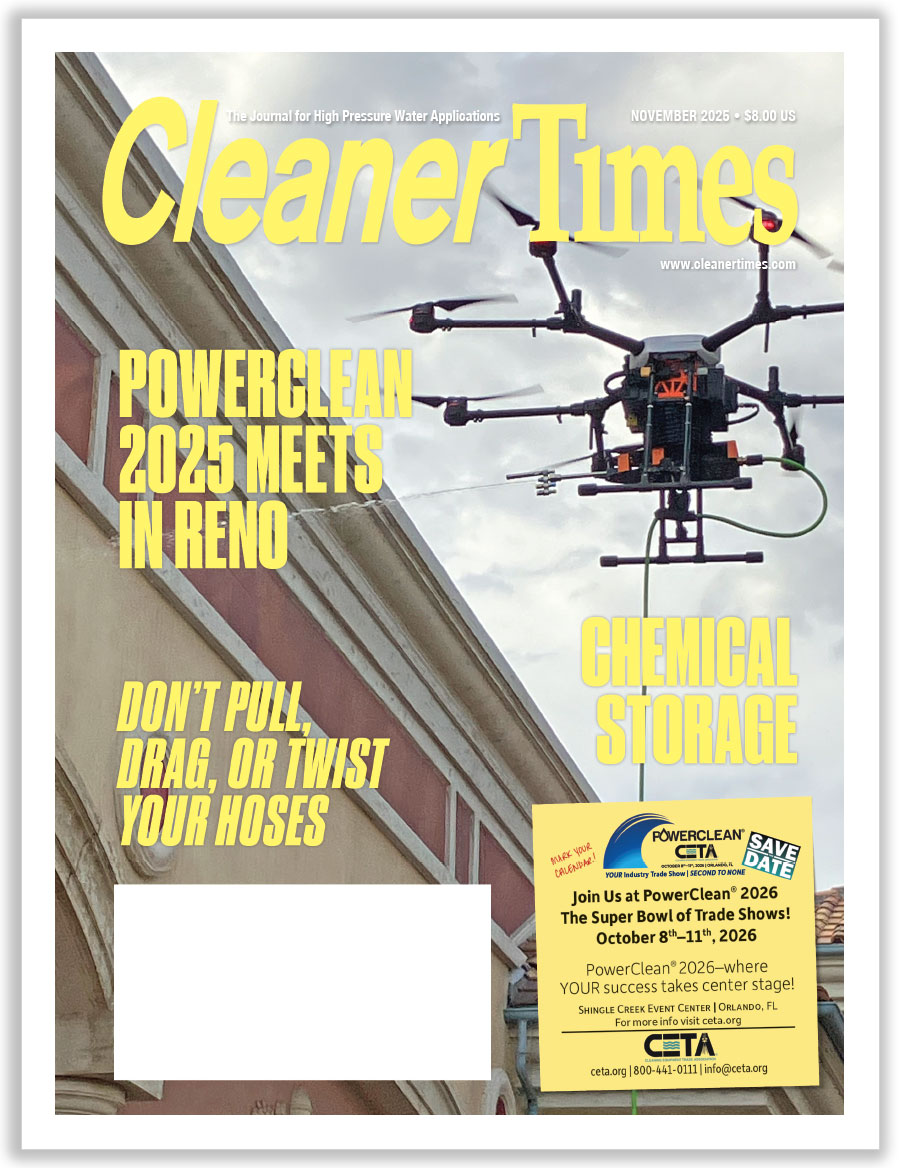
Waterjetting in Paint Booths
By Diane M. Calabrese / Published May 2023

Paint booths may not come in as many shapes and sizes as garden sheds, but they are amazingly varied.
A paint booth is designed to contain coating processes. Containment ensures that if there is errant spray,
it does not go far. Also, containment makes it possible to filter the air to the benefit of the equipment operator and the object being painted.
Air flow and filtering systems draw paint volatile organic compounds (VOCs) away from the painter. The most sophisticated booths have multi-level filtering so that air released outside the booth has minimal impact on the environment.
Paint booths accomplish something else, which is providing adequate illumination. DIY painters know the difficulty in painting the living room without sufficient lighting. It’s easy to miss a spot in a shadow. (Professional painters are way ahead of the DIYers and always compensate for lighting.)
The best containment system and the best equipment operator cannot eliminate all overspray. Over time, a paint booth will accumulate paint as well as dust missed by the filtration system. Paint booths get dirty, and they must be cleaned if they are built for reuse.
Waterjetting tools are among those deployed in cleaning. Solvents, heat, and pressurized dry ice are also in the mix.
The composition and amount of residue to be removed from a paint booth determines the approach. Scrupulous maintenance of all components reduces the accumulation.
To make cleaning easier, many paint booth maintenance schedules include the application of a maskant on the floor and walls. Some paint booths have grates instead of floors underfoot.
Based on the type of filtration system a paint booth has, it may be classified as dry or wet. Dry booths have a filtration system analogous to that in a kitchen hood or furnace. The dry filtering medium captures the overspray. When it does, of course, it becomes increasingly soiled.
Wet (aka, waterwash) paint booths use a mix of chemicals in a water solution as a scrubber to trap airborne residue. To maximize collection, the water-chemical mixes are layered along metal baffles, so what’s missed by the first pass is caught by successive passes. The mix of water and spray then heads to a collection tank.
In a dry booth, the filters must be changed periodically. In a wet booth, the collection tank must be cleaned. Because of the sensitivity of the filters in a dry booth—i.e., they ought not get wet—using waterjetting to clean the booth is not an option.
Dry booths are less expensive to build and maintain, and they are more common. On the other hand, if a dry paint booth begins to get heavier use than was originally expected, filters will have to be changed more often, and more frequent cleaning will be required. As a result, the cost of operation increases.
Much of the routine cleaning of paint booths is done manually. It includes sweeping floors and washing walls with soapy water. All components of paint booths must be monitored and cleaned on an as-needed basis. Periodic inspection of everything from a screw to the fire extinguisher to the light fixture must be done. If components have been coated with paint residue, they must be cleaned.
In wet booths waterjetting may be the best option for some cleaning. That’s especially so if there are grates with caked-on coatings. Maskants applied to booths after washing reduce the
force needed to clean walls and floors.
Design For Balance
Companies that make extensive use of paint booths do not buy off the shelf. They work with a manufacturer that designs and builds to make the booth or booths a good fit.
Filtration systems can be designed for the type of paint (coating) that will be used. Reclamation of residue can be built into a system. Instructions for routine maintenance (including cleaning) will be given with any paint booth, but the instructions are likely to be more precise for a custom build.
The Automobile Manufacturers Association dates to 1999, when it supplanted the American Automobile Manufacturers Association. The latter had an early start on research in how to best clean paint booths.
Automobile manufacturers are among the many product makers committed to identifying best practices in both efficient cleaning and pollution prevention. In case studies in the early 1990s, the manufacturers already made use of water under pressure to clean grates. (The grates on the floor of the spray areas could be flipped so that after one side was cleaned, the other would be exposed to the water under pressure.)
In one case study, a device called a robotic “mower” used 8000 psi emitted from six nozzles on its underside at 25.2 gpm. It took about 30 minutes and 1400 gallons of water to get the cleaning done. Other case studies tested lower pressure and a lower gpm. Using water under pressure reduced or eliminated the need for solvents, but a lot of water was used in all case studies. [To read the entire 34-page report involving auto manufacturers, see https://www.academia.edu/8816199/PAINT_SPRAY_BOOTH_CLEANING_PRACTICES_IN_THE_AUTOMOTIVE_INDUSTRY .]
Customization of paint booths is a way to minimize resource (water, chemical) use and to reduce the number of pollutants released by a process (both the cleaning and initial spraying). To assist companies that use paint booths on a rather small scale, the Environmental Protection Agency (EPA) offers a self-evaluation checklist through its Design for the Environment (DfE) Program.
Any company engaged in auto refinishing (surface preparation, paint mixing, spray painting, spray gun cleaning, and health and safety management) can use the DfE checklist to do a walk-through evaluation. It’s a way to identify and shore up weaknesses in environmental controls.
Such self-evaluation gives any company that uses paint booths a good opportunity to make certain it is compliant with EPA and OSHA [Occupational Safety and Health Administration] regulations governing paint booths. And the OSHA regulations are many. [See last section.]
[The EPA-DfE tool can be found via https://www.epa.gov/sites/default/files/2013-12/documents/checklist_best_practices_auto_refinish_shops_schools.pdf.]
High-pressure water tools and solvents are not, as noted in the first section, the only approaches to cleaning paint booths. Because solid carbon dioxide sublimates to carbon dioxide gas on impact, dry ice blasting can be used to clean paint booths.
Paint booth owners must evaluate not only the outcome with a particular cleaning method but also the cost. Companies that offer paint booth cleaning focus on what will work best for the customer given the type of booth. They rarely operate on a one-size-fits-all-booths approach.
Skids, hooks, and carriers that finesse the comings and goings of objects being painted in booths also must be cleaned. Since they can be moved to an area outside the booth for cleaning, they present opportunities for outside contractors. NLB Corporation in Wixom, MI, notes the utility of high-pressure jets (3500 to 4950 psi) in cleaning such ancillaries. (See https://www.nlbcorp.com/applications/paint-shop-cleaning/.)
Waterjetting tools may also be of service in thoroughly cleaning the tanks that gather water and residue filtered from wet paint booths. Sludge that accumulates in the tanks is scooped out periodically, but after an extended period a paint booth owner will have to decide whether to clean tanks or replace them.
29 CFR §1910.107
OSHA standard 1910.107 (Spray finishing using flammable and combustible materials) is a good guide to the intricacies of spray booths. The booth itself must be substantially constructed of non-combustible material (steel with rigid supports, concrete or masonry) and allow air current flow toward the exhaust outlet.
OSHA prescribes everything from the accessibility to areas within the booth for cleaning to specificity of filters. Filters must be matched to the residue they will capture. The ventilation system must conform with OSHA requirements and NFPA no. 91-1961 (Standard for Blower and Exhaust Systems for Vapor Removal). [NFPA is the National Fire Protection Association].
The focus of OSHA is to ensure all spraying areas have sufficient mechanical ventilation to remove flammable vapors, mist, or powders to a safe confined area without the endangerment of life. The disposal of residue collected by filters and by cleaning (scraping, high-pressure washing, solvent, or dry-ice blasting) must be done at least once a day or at the end of each shift. Fail-safe controls must be in place to disconnect the power supply if there is any failure or stoppage of ventilating fans.
Spray booths must be used only as spray booths. OSHA strictly prohibits alternate use. Moreover, since paint booths are supposed to protect workers through adequate ventilation and containment and capture of residue, they must be separated from one another by a distance of not less than three feet.
The preceding examples are a very short list of rules to which spray booths are subject. When a company contracts for a custom spray booth, it should expect the booth to be OSHA compliant. High-end paint booth manufacturers will also provide ETL, third-party testing verification of their processes.
Safety comes first. Next are efficacy, speed, conservation of resources, and minimization of waste. The best cleaning method meets all objectives. Waterjetting may be the right approach, depending on what’s being cleaned in a booth.






